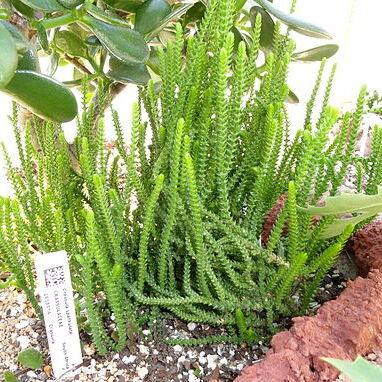Glabrous, perennial herb; stems creeping, trailing and decumbent, rooting at nodes. Lvs with petioles 2-7 mm long, scattered along stems, closer on distal parts, not decussate or imbricate except at stem apices, to 15 × 15 mm, broadly ovate to suborbicular, flat or nearly so, green; margins crenulate and with whitish hydathodes between teeth (hydathodes otherwise 0); base broadly cuneate, rounded or slightly subcordate; apex obtuse or rounded. Infl. a very loose thyrse with ± divaricating branches, to c. 7 cm long, generally wider than long; main axis lacking bracts except at apex. Fls 5-merous, c. 10 mm diam., usually 10-many, on pedicels = or slightly > fls at anthesis. Calyx 0.6-1 mm long; lobes triangular-oblong. Corolla star-like; petals free, patent, 3.5-5 × c. 1 mm, lanceolate-acuminate or narrowly triangular-oblong, pink to rose outside, whitish or pale pink inside. Stamens 2-3 mm long, < carpels. Scales 0.1-0.2 mm long, ± narrowly rectangular (wider than long). Frs and seeds not seen; infls lacking plantlets.
Perennial succulent, prostrate or scrambling, sparsely branched from base, branches quadrangular, ± 0.2-0.4 m long, old leaves not deciduous, adventitious roots at nodes. Leaves ovate, 20-25 x 15-20 mm, acute or obtuse, truncate or cordate base, serrate, yellowish green tinged red along margins; petioles up to 18 mm long. Inflorescence a single dichasia; flowers spreading at right angles; peduncle 30-70 mm long. Calyx ridged, fleshy glabrous, green tinged red. Corolla star-shaped, scarcely fused, white tinged red; lobes linear-lanceolate, 3.0-4.5 mm long, pointed, slightly ridged, hooded, spreading. Flowering time Mar.-May.
Sprawling to prostrate perennial, branches often quadrangular. Leaves opposite, petiole 3-18 mm long, ovate-elliptic, serrate to crenate, margins tinged red. Flowers in terminal clusters, stellate, white often tinged red, petals 3-5 mm long.
A sprawling herb. The branches can often be 4 sided. They can be 80 cm long. The leaves are opposite. They are narrow and 2-2.5 cm long by 1.5-2 cm wide.

